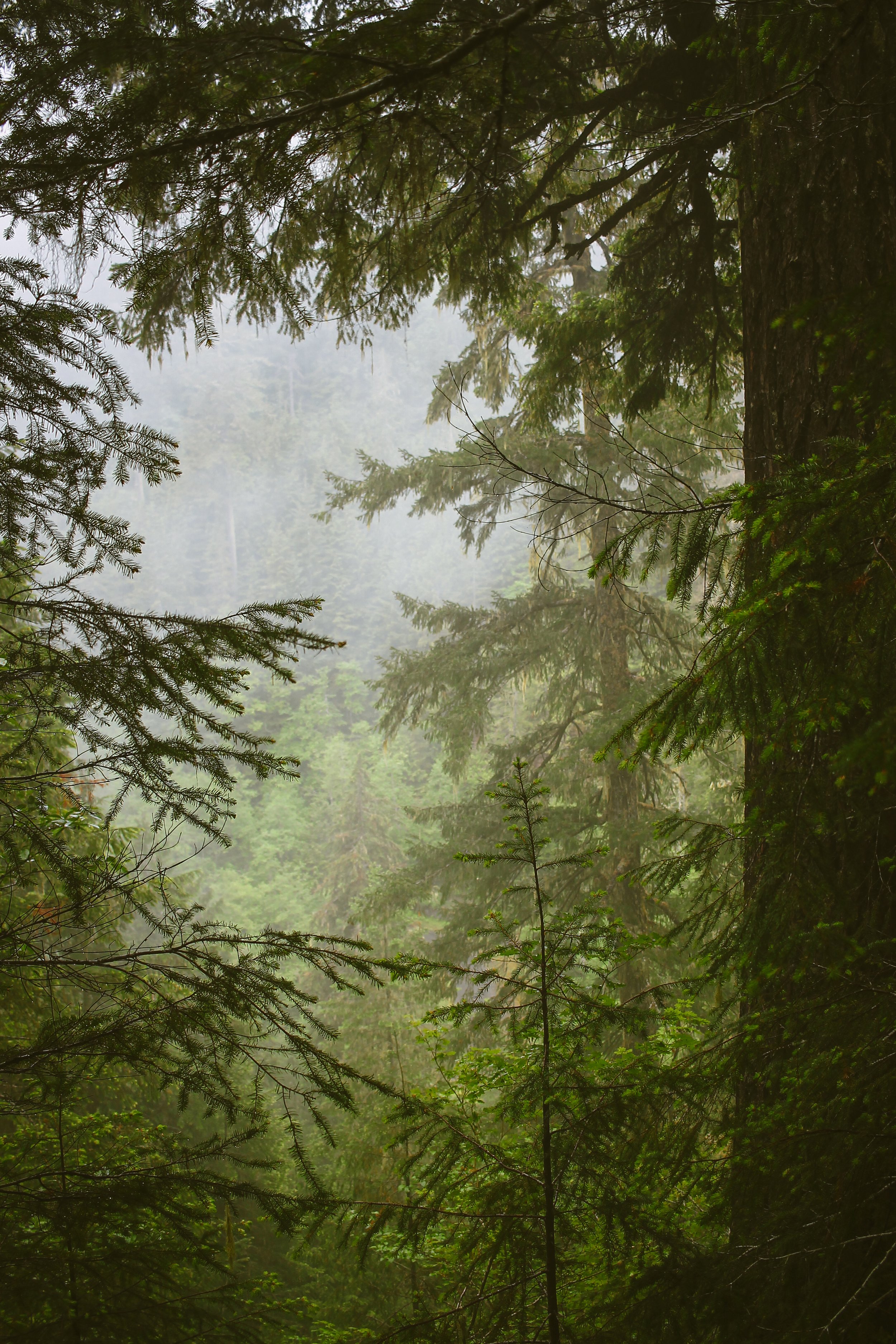The Lost Weekend was a non-competitive rally-style weekend of multi-modal adventure riding with a longform treasure hunt from Seattle to the Olympics and back, staged July 28-30. In the spirit of open-ended adventure and community, the Lost Weekend blurs the lines between bikepacking, trail riding and gravel over three days. The centerpiece of the whole affair is an OMTM-curated adventure ride staged out of Quilcene which traverses the Big Quilcene watershed, Mount Zion and the iconic Bon Jon Pass.
Mt. Zion Edition
53.6 miles | 6128 ft | 60% maintained gravel, 30% paved, 10% singletrack | 42c min – 2” plus | water filter highly recommended
This spirited 53.6-mile adventure showcases the best of the Olympic National Forest’s eastside. The route climbs west out of Quilcene, gently up through primeval forests of Sitka spruce, Douglas fir and western red-cedar before dropping into the Big Quilcene watershed. The route picks up the Lower Big Quilcene Trail at mile 6.5, descending along steep, densely forested ravines, crossing the Big Quilcene river multiple times over rustic forest service bridges. The trail is a mix of moist, earthy needled duff and damp roots and rocks. Steepening northward, a fresh re-route navigates a sequence of switchbacks before angling up out of the valley to the Marmot Pass trailhead at mile 12.7. From here, the route climbs and descends a rousing mix of paved and maintained gravel forest roads to Bon Jon Pass onward to the wild and wonderful two-track of 2849. Riders then descend Salmon Creek Road before turning southward toward Lord’s Lake reservoir for a smooth, rolling glide back into Quilcene.
Gold Creek edition
37.1 miles | 4826 ft | 50% maintained gravel, 30% paved, 20% singletrack | 42c min – 2” plus | water filter highly recommended
This well-rounded adventure shares a common front end with the Mt. Zion Edition – that means, the same trail section, the same wonderful forest road climb and descent sequences toward Bon Jon Pass, where the courses diverge. At mile 27.4, the Gold Creek Edition descends (you guessed it) Gold Creek Road toward Lord’s Lake and a series of gentle serpentine rollers back to Quilcene via Lord’s Lake Loop road.
Gold Creek ALLROAD Edition
31.8 miles | 4152 ft | 60% maintained gravel, 40% paved | 38c min – 45c recommended | water filter highly recommended
This edition simply cuts out the Lower Big Quilcene Trail, opting to stick to the lovely paved climb of 2812-281 before rejoining the other routes at mile 12.2. This edition is for the the skinnytire crowd and those looking for a bit less bob-n-jostle. After reconvening with the rest of the routes at mile 12.2, this edition is identical to the version above.
bainbridge ferry to Quilcene
58.3 miles | 4872 ft | 85% paved, 15% singletrack | 38c min – 45c recommended
The 58 mile ramble from the Bainbridge Ferry to Quilcene may be familiar to some. Highlights include 8 miles of Port Gamble singletrack, the town of Port Gamble itself, the roller-coaster descent through Shine, a mid-ride dip at the Wm R Hicks Beach Park and the enchanted rolling backroads of the Toandos Peninsula. The Port Gamble trail section runs the gamut from smooth gravel forest roads to mildly technical XC singletrack. Our line sticks to drop bar friendly territory and predominantly dreamy-flowy, deeply-forested terrain with plenty of food and bevvie opportunities at the end of the tunnel in Port Gamble.
Quilcene to Bainbridge Ferry
56.8 miles | 4874 ft | 85% paved, 15% singletrack | 38c min – 45c recommended
The route back to the Bainbridge ferry is simply the reverse orientation of the ride out, with some slight adjustments through the Port Gamble trails to optimize for directional flow. Downtown Port Gamble still makes a great mid-ride snack stop, as does the market on Bainbridge near the ferry.
Quilcene
At first glance Quilcene seems like a glorified bend in the road; a scattering of houses, a school, a single restaurant and a pair of bedraggled grocery stores. But like a lot of places, Quilcene starts to reveal itself if you put in the time. There is a distinct art-hippie-anarcho-farmer vibe just below the surface. It is hard to point to anything tangible but you can sort of feel the undercurrent in and around the more conventional small town fare.
You will find a range of options from motel stays, multiple established campgrounds and dispersed camping within the National Forest boundary. We’ve lined up some resources below to assist in planning. Campgrounds are first-come/first-serve. The other, perhaps more open-ended option is dispersed camping in the nearby Olympic National Forest, which is 4.7 miles west of downtown.
Resupply & Food
As we mentioned there are options for grocery, food, bevvies and coffee in Quilcene. Peninsula Foods is well-stocked convenience-grocery in town with all the standards. Quilcene Village Store on the north end of town has a curiously curated selection of cheeses, charcuterie, pastries, smoked meats, produce, tamales and other delectables in addition to more conventional small-grocery fare. Quilbilly’s Restaurant & Taphouse is just down the street serving breakfast, burgers, pizza, salads and offers an unexpectedly well-rounded taplist and lineup of canned craft brews. Do note that they close at 7:30pm, so plan ahead. Additionally you will find both the Quil Bean and PNW Press coffee/espresso carts on the west end of town.
Twana/Skokomish Peoples
The Hood Canal drainage on the Olympic Peninsula’s east side encompasses Skokomish or Twana territory. In translation Skokomish means “people of the big river”. The Skokomish were the largest of at least nine separate tuwaduq speaking peoples who collectively identified as tuwaduq, which has since been anglicized to Twana.
The nine Twana communities were closely related, shared common tuwaduq language traits and lived between the Olympics and Hood Canal, maintaining distinct villages and customs. These nine bands were categorized by their geographic locations, many of which are echoed in the contemporary landscape. Twana communities included those at Quilcene, Skokomish, Dosewallips, Duckabush, Dabob, Tahuya, Duhlelap, Vance Creek and Hoodsport. The nine Twana communities inhabited approximately 33 villages, tracing Twana presence in the Hood Canal region back at least 12,000 years. The Skokomish were one of the largest of the Twana communities and claimed six separate villages along the Skokomish River.
The Olympic Mountain Range, in addition to the Hood Canal waterways, holds a special significance for past and present Skokomish. Twana oral history recalls that Mount Constance and Rainier were once married to Mount Dosewallips. During a heated argument, Rainier decided to leave her husband and relocate southeast to the Cascades. In a hurry, she fumbled, dropping salmon into the rivers along Hood Canal as she left. This is how the Skokomish, Hamma Hamma, Duckabush and Dosewallips Rivers became plentiful with available fish. The Duckabush River and its Twana village were known as the ‘place of the crooked-jawed salmon’, a reference to the region’s Coho salmon.
It was not uncommon for additional tribes to visit Twana lands and vice-versa via canoe and intricate and ancient trail systems crossing the Olympics, which were generally understood to be communal lands. The Quinault came from the Pacific coastline, over 100 miles by foot to attend Twana potlatches along the Hood Canal. Twana potlatches drew large crowds well into the late 1800s. In addition to social and ceremonial events, there exist historical accounts of Twana individuals at Lake Quinault and the mouth of the Columbia where they traded dried clams for mountain goat wool originating from tribes further inland in the Cascades. As a result of their intense trade networks and proclivity for marriage alliances, the Twana spoke many different dialects and were no strangers to the other nations that called the Olympic Peninsula home.





























